Black rot
Learn symptoms, biology, monitoring and management strategies for black rot in apple trees.
Introduction
Black rot is an important disease of apple caused by the fungus Botryosphaeria obtusa. Black rot fungus infects a wide variety of hardwood trees, including apple and pear. Infected trees are often a source of infection for nearby younger bearing blocks. Northern Spy, Cortland, Gala, Honeycrisp, McIntosh and Empire are most often infected, although all apple cultivars are susceptible.
Symptoms
The black rot pathogen infects limbs, trunks, leaves and fruit resulting in reduced productivity and quality of yield. Leaf infections result in a disease called frog-eye leaf spot. On leaves, the disease first appears as a tiny purple fleck which eventually enlarges into a circular lesion about 4–5 mm in diameter (Figure 4-145). The disease often first shows up one to three weeks after petal fall. As the lesion enlarges, the margin remains purple while the centre turns tan or brown with a light centre giving the lesion a "frog-eye" appearance. The optimum temperature for leaf infections is around 26.6°C with 4.5 hours of leaf wetness.
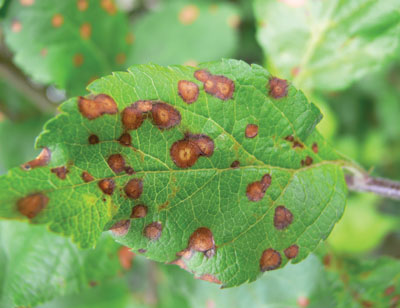
Severely infected leaves eventually turn yellow and drop, resulting in premature senescence of affected trees and predisposing them to winter injury. Defoliation year after year stresses trees and greatly reduces vigour. Damage to limbs caused by cankers from other disease - or wounds caused by insects, pruning and hail or winter injury - provide an entrance for the fungus to invade and become established. Fire blight cankers are often colonized by black rot fungus. Limb cankers first appear as reddish or pinkish, brown sunken areas in the bark (Figure 4-146). Cankers often remain small and superficial but sometimes enlarge up to 50 cm in length along the infected limb, killing and cracking the bark. As the canker ages, the wood shrinks and becomes black as the bark peels away from the infected area (Figure 4-147). Cankers on limbs cause the entire limb to die back. Severely cankered limbs are weakened to the point that they may break under heavy fruit loads. Infections on the main trunk, particularly on young trees, eventually girdle the tree resulting in premature death.
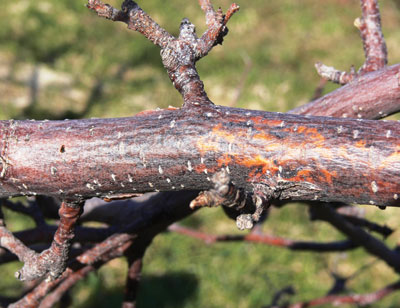
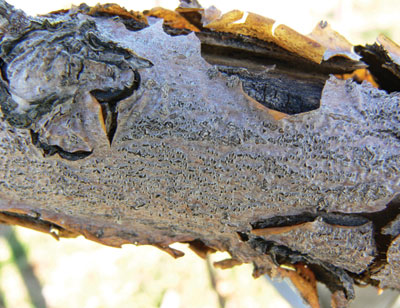
Initial symptoms on young fruit appear as red flecks that develop into purplish, slightly raised pimples which often go unnoticed at first (Figure 4-148). As the fruit begins to mature and ripen, lesions begin to enlarge and develop into a sunken black spot surrounded by a red halo (Figure 4-149). The lesion eventually enlarges into a light or tan brown rot with concentric dark and light rings (Figure 4-150). Colonized mummified fruit are often located in close proximity to the black-rot infected fruit. Black rot often appears late in the season just before harvest as black spots on the fruit associated with mummified fruit left from chemical thinners. Black pycnidia may appear on fruit late in the growing season or in storage (Figure 4-151).
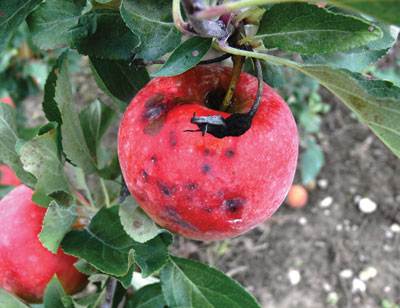
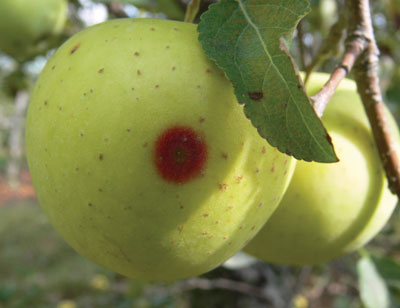
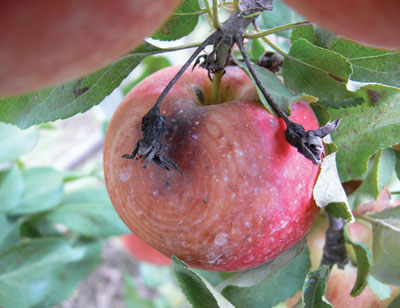
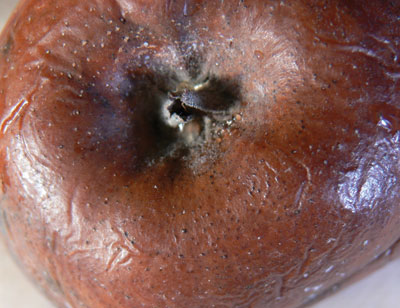
Sepals of fruit become infected early in the season just after bud scales become loose. Red flecks that turn purple surrounded by red rings on sepals are the first symptoms of early infection. As the fruit matures, the fungus penetrates the fruit from the calyx causing calyx end rot (Figure 4-152). Eventually, concentric dark and light rings form and the fungus grows into the core causing core rot and resulting in premature fruit drop.
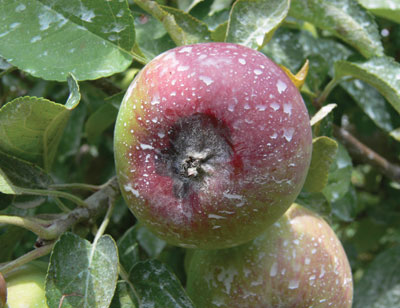
Biology
Black rot fungus overwinters in cankers on twigs, branches and trunks of many hardwood trees, as well as on mummified fruit. Apple cultivars which retain mummified fruit such as Gala, Honeycrisp, Cortland and Northern Spy are often susceptible to black rot. Trees damaged by winter injury or fire blight infections are more susceptible to black rot.
The fungus produces two types of inoculum — ascospores (sexual spores) and conidia from pycnidia (asexual spores). Ascospores from cankers or colonized mummified fruit, tend to be released early in the growing season as buds begin to swell and open. The heaviest ascospore release occurs for a four to six week period following petal fall. Conidia are released from pycnidia throughout the growing season starting soon after bud break. Ascospores are wind blown, and conidia require a wet period and rain splashing for release. Frequent and heavy rain events are the main factors influencing spore release. The optimum temperature for leaf infections is 26°C accompanied by four to five hours of leaf wetting, and fruit infections occur at 20-24°C with nine hours of wetting. Risk of infections is low when temperatures are below 10°C (more than 24 hours of leaf wetness required), and none occur below 8°C. Leaf and fruit infections occur simultaneously in the spring.
Monitoring and management
Managing black rot in orchards relies on the integration of cultural and chemical methods together in an integrated pest management program. There are no cultivars completely resistant to black rot, but some are less susceptible to this disease than others (Table 4-11). Selecting cultivars that are less susceptible to black rot for planting near sources of disease (woodlots) may help reduce yield losses.
Pruning out diseased limbs and dead wood is an important practice to reduce the inoculum sources within the orchard. It is important to remove prunings from the orchard or burn them since black rot fungus can survive on dead tissue. Alternatively, chopping up the prunings on the orchard floor with a flail mower reduces inoculum levels. Woodpiles must not be stacked in or near orchards since they can be a major source of inoculum. Make an attempt to scout surrounding woodlots and identify hardwood trees infected with the disease. If possible, remove and burn these trees to decrease potential disease pressure. It is important to obtain a neighbour's permission to cut down infected trees identified on an adjacent property.
| Cultivar | Relative susceptibility |
|---|---|
| Arlet | Moderately susceptible |
| Braeburn | Less susceptible |
| Cameo | Moderately susceptible |
| Creston | Less susceptible |
| Enterprise | Less susceptible |
| Fortune | Moderately susceptible |
| Fuji | Less susceptible |
| Gala Supreme | Less susceptible |
| Ginger Gold | Moderately susceptible |
| Golden Delicious | Less susceptible |
| Golden Supreme | Moderately susceptible |
| Goldrush | Less susceptible |
| Honeycrisp | Moderately susceptible |
| NY75414 | Moderately susceptible |
| Orin | Very susceptible |
| PioneerMac | Moderately susceptible |
| Pristine | Very susceptible |
| Sansa | Moderately susceptible |
| Seshu | Moderately susceptible |
| Shizuka | Moderately susceptible |
| Suncrisp | Moderately susceptible |
| Sunrise | Very susceptible |
| Ytaka | Moderately susceptible |
Adapted from: Biggs, A.R and Miller, S.S. 2004. Relative Susceptibility of Selected Apple Cultivars to Fruit Rot Caused by Botryosphaeria obtuse. HortScience 39:303-306.
Mummified fruit left in trees often become infected with the fungus and remain as a source of inoculum within the orchard. Removal of mummified fruit helps reduce the spread of the disease. Research shows some chemical thinners leave small immature fruitlets that become mummified and infected with the black rot fungus, and a source of inoculum later in the season. Research shows applying chemical thinners when fruit are 6–8 mm rather than 12–14 mm reduces the number of mummified fruitlets left in the orchard, resulting in less black rot on mature fruit at harvest.
In orchards with a history of black rot, initiate applications of registered fungicides at silver tip and continue on a 10–14 day schedule to protect leaves and fruit from black rot infection. For a list of products effective in managing black rot, see OMAFRA Publication 360, Fruit Production Recommendations.